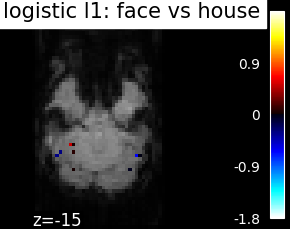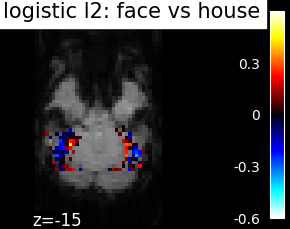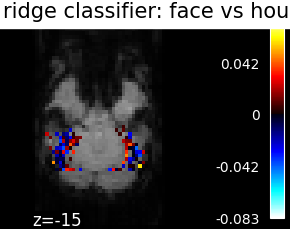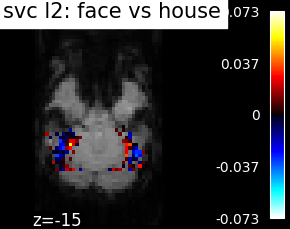Note
Click here to download the full example code or to run this example in your browser via Binder
Different classifiers in decoding the Haxby dataset#
Here we compare different classifiers on a visual object recognition decoding task.
Loading the data#
# We start by loading data using nilearn dataset fetcher
from nilearn import datasets
from nilearn.image import get_data
# by default 2nd subject data will be fetched
haxby_dataset = datasets.fetch_haxby()
# print basic information on the dataset
print('First subject anatomical nifti image (3D) located is at: %s' %
haxby_dataset.anat[0])
print('First subject functional nifti image (4D) is located at: %s' %
haxby_dataset.func[0])
# load labels
import numpy as np
import pandas as pd
labels = pd.read_csv(haxby_dataset.session_target[0], sep=" ")
stimuli = labels['labels']
# identify resting state (baseline) labels in order to be able to remove them
resting_state = (stimuli == 'rest')
# extract the indices of the images corresponding to some condition or task
task_mask = np.logical_not(resting_state)
# find names of remaining active labels
categories = stimuli[task_mask].unique()
# extract tags indicating to which acquisition run a tag belongs
session_labels = labels['chunks'][task_mask]
# Load the fMRI data
# For decoding, standardizing is often very important
mask_filename = haxby_dataset.mask_vt[0]
func_filename = haxby_dataset.func[0]
# Because the data is in one single large 4D image, we need to use
# index_img to do the split easily.
from nilearn.image import index_img
fmri_niimgs = index_img(func_filename, task_mask)
classification_target = stimuli[task_mask]
First subject anatomical nifti image (3D) located is at: /home/alexis/nilearn_data/haxby2001/subj2/anat.nii.gz
First subject functional nifti image (4D) is located at: /home/alexis/nilearn_data/haxby2001/subj2/bold.nii.gz
Training the decoder#
# Then we define the various classifiers that we use
classifiers = ['svc_l2', 'svc_l1', 'logistic_l1',
'logistic_l2', 'ridge_classifier']
# Here we compute prediction scores and run time for all these
# classifiers
import time
from nilearn.decoding import Decoder
from sklearn.model_selection import LeaveOneGroupOut
cv = LeaveOneGroupOut()
classifiers_data = {}
for classifier_name in sorted(classifiers):
print(70 * '_')
# The decoder has as default score the `roc_auc`
decoder = Decoder(estimator=classifier_name, mask=mask_filename,
standardize=True, cv=cv)
t0 = time.time()
decoder.fit(fmri_niimgs, classification_target, groups=session_labels)
classifiers_data[classifier_name] = {}
classifiers_data[classifier_name]['score'] = decoder.cv_scores_
print("%10s: %.2fs" % (classifier_name, time.time() - t0))
for category in categories:
print(" %14s vs all -- AUC: %1.2f +- %1.2f" % (
category,
np.mean(classifiers_data[classifier_name]['score'][category]),
np.std(classifiers_data[classifier_name]['score'][category]))
)
# Adding the average performance per estimator
scores = classifiers_data[classifier_name]['score']
scores['AVERAGE'] = np.mean(list(scores.values()), axis=0)
classifiers_data[classifier_name]['score'] = scores
______________________________________________________________________
logistic_l1: 17.87s
scissors vs all -- AUC: 0.92 +- 0.05
face vs all -- AUC: 0.98 +- 0.02
cat vs all -- AUC: 0.96 +- 0.04
shoe vs all -- AUC: 0.92 +- 0.08
house vs all -- AUC: 1.00 +- 0.00
scrambledpix vs all -- AUC: 0.99 +- 0.01
bottle vs all -- AUC: 0.90 +- 0.08
chair vs all -- AUC: 0.91 +- 0.06
______________________________________________________________________
logistic_l2: 53.16s
scissors vs all -- AUC: 0.91 +- 0.08
face vs all -- AUC: 0.97 +- 0.04
cat vs all -- AUC: 0.97 +- 0.03
shoe vs all -- AUC: 0.92 +- 0.09
house vs all -- AUC: 1.00 +- 0.00
scrambledpix vs all -- AUC: 0.96 +- 0.11
bottle vs all -- AUC: 0.82 +- 0.18
chair vs all -- AUC: 0.89 +- 0.18
______________________________________________________________________
ridge_classifier: 26.72s
scissors vs all -- AUC: 0.91 +- 0.08
face vs all -- AUC: 0.96 +- 0.03
cat vs all -- AUC: 0.91 +- 0.07
shoe vs all -- AUC: 0.91 +- 0.07
house vs all -- AUC: 1.00 +- 0.00
scrambledpix vs all -- AUC: 0.99 +- 0.01
bottle vs all -- AUC: 0.85 +- 0.10
chair vs all -- AUC: 0.91 +- 0.06
______________________________________________________________________
svc_l1: 35.46s
scissors vs all -- AUC: 0.92 +- 0.05
face vs all -- AUC: 0.98 +- 0.03
cat vs all -- AUC: 0.96 +- 0.04
shoe vs all -- AUC: 0.92 +- 0.07
house vs all -- AUC: 1.00 +- 0.00
scrambledpix vs all -- AUC: 0.99 +- 0.01
bottle vs all -- AUC: 0.89 +- 0.08
chair vs all -- AUC: 0.93 +- 0.04
______________________________________________________________________
svc_l2: 83.25s
scissors vs all -- AUC: 0.90 +- 0.09
face vs all -- AUC: 0.96 +- 0.05
cat vs all -- AUC: 0.96 +- 0.04
shoe vs all -- AUC: 0.91 +- 0.08
house vs all -- AUC: 1.00 +- 0.00
scrambledpix vs all -- AUC: 0.96 +- 0.10
bottle vs all -- AUC: 0.82 +- 0.17
chair vs all -- AUC: 0.87 +- 0.16
Visualization#
# Then we make a rudimentary diagram
import matplotlib.pyplot as plt
plt.figure(figsize=(6, 6))
all_categories = np.sort(np.hstack([categories, 'AVERAGE']))
tick_position = np.arange(len(all_categories))
plt.yticks(tick_position + 0.25, all_categories)
height = 0.1
for i, (color, classifier_name) in enumerate(zip(['b', 'm', 'k', 'r', 'g'],
classifiers)):
score_means = [
np.mean(classifiers_data[classifier_name]['score'][category])
for category in all_categories
]
plt.barh(tick_position, score_means,
label=classifier_name.replace('_', ' '),
height=height, color=color)
tick_position = tick_position + height
plt.xlabel('Classification accuracy (AUC score)')
plt.ylabel('Visual stimuli category')
plt.xlim(xmin=0.5)
plt.legend(loc='lower left', ncol=1)
plt.title(
'Category-specific classification accuracy for different classifiers')
plt.tight_layout()
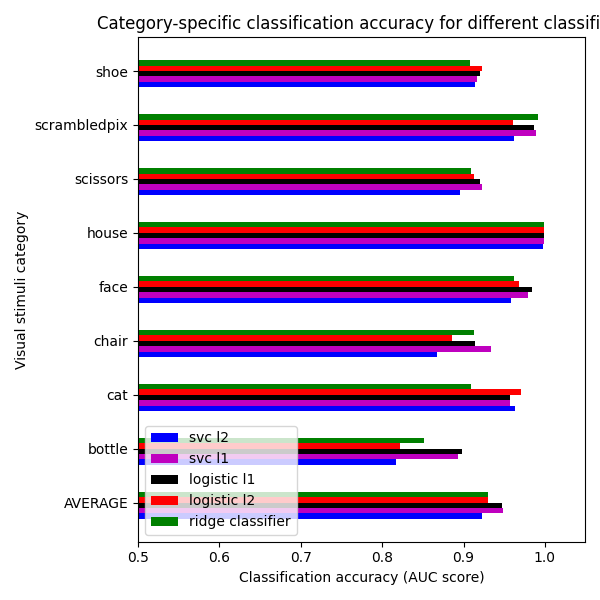
We can see that for a fixed penalty the results are similar between the svc and the logistic regression. The main difference relies on the penalty ($ell_1$ and $ell_2$). The sparse penalty works better because we are in an intra-subject setting.
Visualizing the face vs house map#
Restrict the decoding to face vs house
condition_mask = np.logical_or(stimuli == 'face', stimuli == 'house')
stimuli = stimuli[condition_mask]
assert len(stimuli) == 216
fmri_niimgs_condition = index_img(func_filename, condition_mask)
session_labels = labels['chunks'][condition_mask]
categories = stimuli.unique()
assert len(categories) == 2
for classifier_name in sorted(classifiers):
decoder = Decoder(estimator=classifier_name, mask=mask_filename,
standardize=True, cv=cv)
decoder.fit(fmri_niimgs_condition, stimuli, groups=session_labels)
classifiers_data[classifier_name] = {}
classifiers_data[classifier_name]['score'] = decoder.cv_scores_
classifiers_data[classifier_name]['map'] = decoder.coef_img_['face']
Finally, we plot the face vs house map for the different classifiers Use the average EPI as a background
from nilearn.image import mean_img
from nilearn.plotting import plot_stat_map, show
mean_epi_img = mean_img(func_filename)
for classifier_name in sorted(classifiers):
coef_img = classifiers_data[classifier_name]['map']
threshold = np.max(np.abs(get_data(coef_img))) * 1e-3
plot_stat_map(
coef_img, bg_img=mean_epi_img, display_mode='z', cut_coords=[-15],
threshold=threshold,
title='%s: face vs house' % classifier_name.replace('_', ' '))
show()
Total running time of the script: ( 4 minutes 1.775 seconds)
Estimated memory usage: 1347 MB
